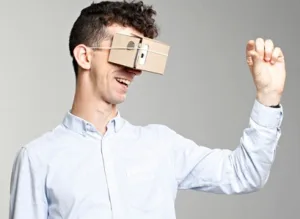In a recent article (Is Educational VR Content Ready for Prime Time?), my colleague Len Scrogan bemoaned the lack of VR content for education. Having just returned from BETT – arguably Europe’s largest technology show for the education market – this seems like a perfect time to weigh in with my views on VR in schools.

For several years, BETT has been seeing more investment in large-format LCD displays and less in projection – although that is not to say that projectors are dead in the water. Epson, Casio and others were showing projectors, and their stands were very busy. I noticed that many companies were focusing around new software, primarily to do with collaboration, or hybrid tablet/notebook devices. Something was missing, though – and that was VR.
We’re only one month into the year, and already industry watchers (and the media) are calling 2016 ‘the year of VR’. The big-name devices, like the Oculus Rift, HTC Vive and Playstation VR, are all set to be released in the first half. The problem with these? They are all high-end products, requiring attached PCs or accessories to be used. Can you see a school splashing out $1,000 for a PC to be used with the Oculus, when every child – realistically – would need a headset? Or setting up multiple spaces for the Vive’s tracking features to be used optimally? Of course not.
That is why the cheaper option – headsets using smartphones as the display – are likely to be the main way in which students view VR content in schools. In many cases, the school will simply supply the headset and supporting control system, while the students use their own phones as the display. Gone are the days in which a child would get detention for bringing a phone to school!
At BETT, the only VR demonstration I saw was an off-stand pilot from Google, called Google Expeditions (http://tinyurl.com/gqwste4). It would rely on exactly the type of BYOD set-up described above, with the school handing out Google Cardboard headsets to the students. The Expeditions programme runs through an app downloaded to each phone.
Expeditions is a completely curated experience for the students – up to 50 – controlled by the teacher (yes, it’s more of that passive learning reviled by school boards!) via Bluetooth. Control can be from a tablet or PC. The teacher sends 360° VR panorama-style images to the students’ devices for them to view; in my time there we saw the Earth from space, before visiting the Great Barrier Reef, a cliff face in the USA and Buckingham Palace. Because the content comes from an app, it appeared very quickly, without loading times.
Teachers are able to highlight areas of an image to draw attention to them; for instance, a geographical feature, or a school of fish. Students who are focused on a different part of the image will see an arrow pointing towards the area of interest. The teacher is able to track attention, as the UI on their device shows where each pupil is looking on the image (although doesn’t name the students).
Currently, all content (there are more 100 Expeditions at the time of writing) is static. Video may be added in the future, but this would increase load times. Still, what a tool it would be for education to drop a student in the middle of the African savannah, or the Large Hadron Collider in Switzerland. Cheaper than a field trip, too!
The educators at the demonstration were all very impressed with the concept, and so was I. However, I was left wondering when schools would be able to move beyond passive content like this, and interact with scenes, as VR is intended to be used. Sadly, the devices that can do this might be beyond the budgets of most institutions, at least until a major consumer market has been enabled.
– Tom Allen

